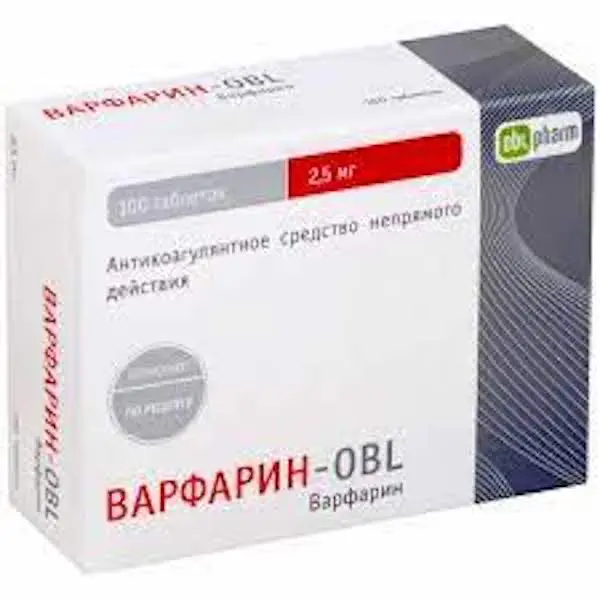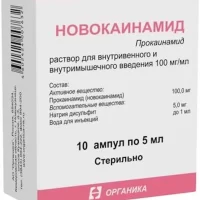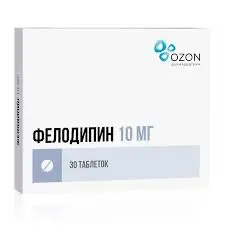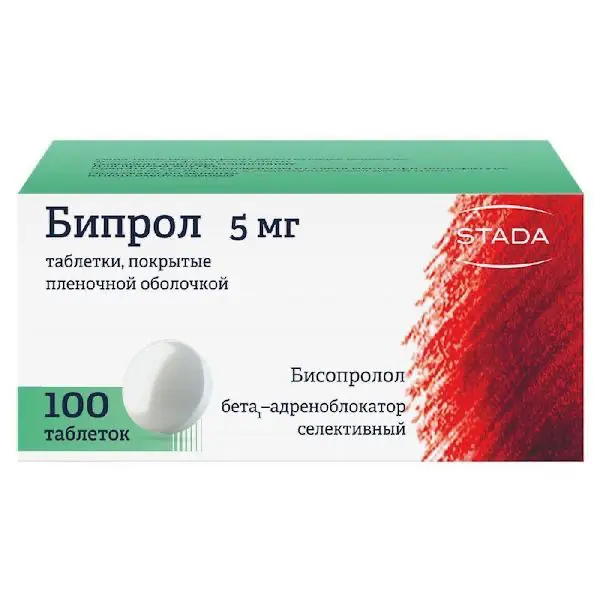Description
Warfarin Pharmacodynamics
Warfarin is an indirect acting anticoagulant. Inhibits in the liver synthesis of vitamin K-dependent clotting factors (II, VII, IX and X) and proteins C and S. Optimal anticoagulant effect is observed on days 3-5 from the start of use. After discontinuation of warfarin, restoration of activity of vitamin K-dependent clotting factors occurs within 4-5 days. Warfarin has no direct effect on the formed clot and does not eliminate ischemic tissue damage.
Indications
– Treatment and prevention of venous thrombosis and thromboembolisms (acute and recurrent venous thrombosis, pulmonary embolism).
– Secondary prevention of myocardial infarction and prevention of thromboembolic complications after myocardial infarction.
– Prevention of thromboembolic complications in patients with atrial fibrillation, heart valve lesions or with prosthetic heart valves.
– Treatment and prevention of transient ischemic attacks and ischemic stroke.
– Prevention of postoperative thrombosis.
Contraindications
– Established or suspected hypersensitivity to warfarin or any of the excipients of the drug.
– Acute bleeding.
– Thrombocytopenia.
– Acute DIC syndrome.
– Protein C and S deficiency.
– Increased risk of bleeding, including use in patients with hemorrhagic disorders, esophageal varices, arterial aneurysms, lumbar puncture, gastric and duodenal ulcers, with severe wounds (including surgical), bacterial endocarditis, malignant arterial hypertension, hemorrhagic stroke, intracranial hemorrhage.
– Severe renal and/or hepatic failure.
– Pregnancy (first and third trimester).
– Lactose intolerance, lactase deficiency and glucose-gapacose malabsorption syndrome.
Caution
Elderly age, fever, hyper- and hypothyroidism, decompensated heart failure, alcoholism with concomitant liver damage, mild to moderate renal failure, nephrotic syndrome, moderate hepatic failure, dementia.
Administration during pregnancy and lactation
Pregnancy
Warfarin quickly crosses the placenta and has teratogenic effect on placenta, resulting in development of warfarin syndrome in fetus at 6-12 weeks of pregnancy. Manifestations of this syndrome: nasal hypoplasia (saddle nose deformity and other cartilage changes) and point chondrodysplasia on x-ray examination (especially in the spine and long tubular bones), short hands and fingers, optic atrophy, cataracts leading to complete or partial blindness, mental and physical development delay and microcephaly.
Warfarin use during pregnancy may cause birth defects and lead to fetal death.
Warfarin should not be used in the first and third trimesters of pregnancy. Warfarin use is not recommended during the remainder of pregnancy, unless absolutely necessary.
Women of reproductive age should use effective methods of contraception while using warfarin. Breastfeeding period
Warfarin is excreted in breast milk, but no adverse effects on the nursing infant are expected when therapeutic doses of warfarin are taken. Warfarin may be used during breastfeeding if the benefit to the mother exceeds the expected risk to the baby.
Fertility
There are no data on the effect of warfarin on fertility.
Dosage and administration
- Inside, once a day, preferably at the same time of day. The duration of treatment is determined by the physician in accordance with the indications for use.
- Control during treatment
- International Normalized Ratio (INR) is determined before starting therapy. Thereafter laboratory control is performed regularly every 4 to 8 weeks. Treatment duration depends on clinical condition of patient. Treatment may be withdrawn immediately.
- Patients who have not previously taken Warfarin
The initial dose is 5 mg/day (2 tablets of 2.5 mg per day) during the first 4 days of therapy. On the 5th day of treatment, the INR is determined and the maintenance dose of the drug is prescribed in accordance with this figure. Usually the maintenance dose of this medicine is 2.5-7.5 mg per day (1-3 tablets of 2.5 mg per day). - Patients who have previously taken Warfarin
The recommended starting dose is double the known maintenance dose of the drug and is administered for the first 2 days. Treatment is then continued with a known maintenance dose. On the 5th day of treatment, the INR is monitored and the dose is adjusted accordingly. It is recommended to maintain INR between 2 and 3 in case of prevention and treatment of venous thrombosis, pulmonary embolism, atrial fibrillation, dilated cardiomyopathy, complicated heart valve diseases, heart valve prosthesis with bioprostheses. Higher INR values of 2.5 to 3.5 are recommended for prosthetic heart valves with mechanical prostheses and complicated acute myocardial infarction. - Children
Data on the use of warfarin in children are limited. The initial dose is usually 0.2 mg/kg per day for normal liver function and 0.1 mg/kg per day for impaired liver function. The maintenance dose is adjusted according to INR values. The recommended INR values are the same as in adults. The decision to use Warfarin in children should be made by a specialist. Treatment should be carried out under the supervision of an experienced pediatrician. Doses are chosen according to the table below.
Day 1 If the baseline INR is 1.0 to 1.3, the shock dose is 0.2 mg/kg body weight.
Days 2 through 4, if INR value: 1 to 1.3 1/4 to 1.9 2.0 to 3.0 3.1 to 3.5 >3.5 Action: repeat shock dose; 50% of shock dose; 50% of shock dose; 25% of shock dose; Discontinue drug until INR value < 3.5, then resume treatment with a dose that is 50% of the previous dose.
Maintenance if INR value: 1 to 1.3 1.4 to 1.9 2.0 to 3.0 3.1 to 3.5 >3.5 Action (weekly dose): increase dose by 20%; increase dose by 10%; no change; reduce dose by 10%; discontinue drug until INR < 3.5, then resume treatment with a dose 20% less than the previous dose - Elderly patients
There are no specific recommendations for the use of Warfarin in elderly patients. However, elderly patients should be closely monitored, as they have a higher risk of side effects.





